|
 Muay Thai started way back in
the medieval ages when wars were fought with bow and arrows, swords and pikes. And in hand-to-hand combat arms, legs, knees,
and elbows were also used as weapons. This sport which was included in military training was made famous by King Naresuan
1560 A.D. During one of the many battles between Burma and Siam, he was captured. The Burmese knew of his prowess as the best
unarmed fighter in the realm and gave him a chance to fight with their best for his freedom. Upon his return to Siam he was
hailed as a hero and Siamese-style boxing, as it was called then, was soon recognized as a national sport. Boxing in this
style reached its zenith of popularity about two hundred years ago, i.e., in the reign of Prachao Sua (King Tiger), when it
was indulged in by all classed of the population.
Muay Thai started way back in
the medieval ages when wars were fought with bow and arrows, swords and pikes. And in hand-to-hand combat arms, legs, knees,
and elbows were also used as weapons. This sport which was included in military training was made famous by King Naresuan
1560 A.D. During one of the many battles between Burma and Siam, he was captured. The Burmese knew of his prowess as the best
unarmed fighter in the realm and gave him a chance to fight with their best for his freedom. Upon his return to Siam he was
hailed as a hero and Siamese-style boxing, as it was called then, was soon recognized as a national sport. Boxing in this
style reached its zenith of popularity about two hundred years ago, i.e., in the reign of Prachao Sua (King Tiger), when it
was indulged in by all classed of the population.

From those days up until the early part of this country, the fighters, particularly those in
provinces, used horsehide strip and later hemp in lieu of gloves. It was also a practice at one time to grind pieces of glass
into the hemp if both contestants agreed. Since these practices were obviously dangerous to the fighters' health, regular
boxing gloves were introduced about 50 years ago and have been used ever since.
To the Thais, Muay Thai is regarded as a prestigious national sport. Thai boys will in one
or another way, intentionally or unintentionally, learn how to box Thai style. Even Thai girls will know enough of the basic
principles and to be able to use it for self-defense when necessary.
Muay Thai, called Thai Boxing by foreigners, is our national sport and is now getting more
popular in many countries, especially in Japan where a large number of young Japanese are now being trained to fight professionally.
But in Japan this fight is called "Kick Boxing." At present "Kick Boxing" is internationally known as a Japanese martial art.
Surely the true name, "Muay Thai" should be retained internationally as the Japanese terms Kendo, Judo, or Karate have been.
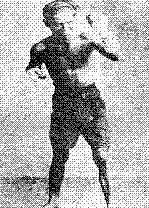 There is no real evidence to show the time of origin of Thai-Style boxing. It can only be assumed
that Thai boxing existed since the Thai emigrated from the South of China.
They had to hide from attackers and meet with resistance from local people. In short, they
had to fight endlessly for their survival. By the time they managed to settle in the "Gold Promontory", the Thais had gone
enough countless battles and many lives had been lost.
The ancient weapons consisted only of spears, swords, pikes or bows and arrows. But in hand-to-hand
combat weapons become clumsy, and elbows, knees, feet and fits became more practical. This must have been extremely successful,
as it was then developed into a form of martial arts used in battle, and this was the origin of Muay Thai, superior to any
other form of martial arts.
When the Thais finally settled down and built a city, and extended their territory to become
a large country, there was a need for an army to defend the country. Soldiers in those days had to learn Muay Thai along with
the use of traditional weapons.
There is no real evidence to show the time of origin of Thai-Style boxing. It can only be assumed
that Thai boxing existed since the Thai emigrated from the South of China.
They had to hide from attackers and meet with resistance from local people. In short, they
had to fight endlessly for their survival. By the time they managed to settle in the "Gold Promontory", the Thais had gone
enough countless battles and many lives had been lost.
The ancient weapons consisted only of spears, swords, pikes or bows and arrows. But in hand-to-hand
combat weapons become clumsy, and elbows, knees, feet and fits became more practical. This must have been extremely successful,
as it was then developed into a form of martial arts used in battle, and this was the origin of Muay Thai, superior to any
other form of martial arts.
When the Thais finally settled down and built a city, and extended their territory to become
a large country, there was a need for an army to defend the country. Soldiers in those days had to learn Muay Thai along with
the use of traditional weapons.
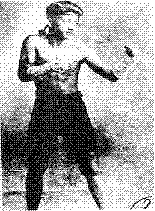 Thus there was also the need for Kru Muay, or teacher of Thai boxing. Various tactics for attack
and defense were developed, called "boxing tactics". Later, layman began to take up this form of fighting, as a form of self-defense,
and as a handy qualification to become a soldier, which would also lead to further advancement depending on their ability
and talent.
During Ayutthaya, which was a period of consecutive fighting against the neighboring countries
of Burma, Cambodia and Vietnam, history records state that King Sri San Petch or Khun Luang Sorasak known as Phra Chao Sua
(The Tiger King) often boxed incognito in various up-country temple fairs. He is said to have been a skilled boxer, and enjoyed
the sport so much that he often disguised himself thus in order to test his skill against villager and thus became quite a
legend in his own time.
When Ayutthaya fell in 1767 A.D. many Thais became prisoners of war. In 1774 the King of Burma
held a festival to celebrate the Chedi containing the Buddha's relics in Rangoon, with various forms of entertainment and
festivities. This included a boxing display for the King by a boxer named "Nai Khanom Tom" a prisoner of war from Ayutthaya.
Pit against Burmese boxers, Nai Khanom Tom defeated 10 Burmese opponents in a row, and also became quite a legend.
During the reign of King Tak Sin the Great, the King had a close aide-de-camp named "Phraya
Pichai Dab Hak" who studied the art of Muay Thai with many famous teachers and displayed his talent for the King. As a result,
he was chosen to become a soldier, and was later promoted to the position of Chao Muang (governor) with his name recorded
in history.
Thus there was also the need for Kru Muay, or teacher of Thai boxing. Various tactics for attack
and defense were developed, called "boxing tactics". Later, layman began to take up this form of fighting, as a form of self-defense,
and as a handy qualification to become a soldier, which would also lead to further advancement depending on their ability
and talent.
During Ayutthaya, which was a period of consecutive fighting against the neighboring countries
of Burma, Cambodia and Vietnam, history records state that King Sri San Petch or Khun Luang Sorasak known as Phra Chao Sua
(The Tiger King) often boxed incognito in various up-country temple fairs. He is said to have been a skilled boxer, and enjoyed
the sport so much that he often disguised himself thus in order to test his skill against villager and thus became quite a
legend in his own time.
When Ayutthaya fell in 1767 A.D. many Thais became prisoners of war. In 1774 the King of Burma
held a festival to celebrate the Chedi containing the Buddha's relics in Rangoon, with various forms of entertainment and
festivities. This included a boxing display for the King by a boxer named "Nai Khanom Tom" a prisoner of war from Ayutthaya.
Pit against Burmese boxers, Nai Khanom Tom defeated 10 Burmese opponents in a row, and also became quite a legend.
During the reign of King Tak Sin the Great, the King had a close aide-de-camp named "Phraya
Pichai Dab Hak" who studied the art of Muay Thai with many famous teachers and displayed his talent for the King. As a result,
he was chosen to become a soldier, and was later promoted to the position of Chao Muang (governor) with his name recorded
in history.
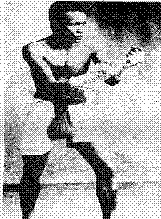 In the Ratanakosin Period, Muay Thai was still a national art form, with competitions in annual
national festivities. Time-keeping was done by floating a pierced coconut shell. When thecoconut sank, a drum would be beaten
to signal the end of a round.
In 1788, during the reign of King Rama I, two French brothers arrived in Thailand by boat,
having defeated many boxer across the Indo-China Peninsula. King Rama I consulted the Crown Prince, his brother, who offered
to find boxers to fight against the Frenchmen. Phraya Phra Klang wouldaccept the challenge, settling the bet at 50 chang (4,000
baht).
The Crown Prince chose a boxer named Muen Plan of the Royal Guards. The match was held in the
grounds of the Grand Palace. Muen Plan wore full battle regalia -- bare-chested, seeped in magic charm, cabalistic writing
and oils to ensure invulnerability.
When the fight began, the large French fighter tried to attack, aiming for the neck and collar
bone. Muen Plan defended himself with Muay Thai.
The other Frenchman, seeing his brother making no progress became frustrated, and pushed Muen
Plan's back to stop him from backing away. Members of the Royal Guards saw this break of boxing etiquette and proceeded to
help Muen Plan tackle the two Frenchmen until they had to carried back to the boat. They set sail the next day, with no thought
of ever challenging a Thai Boxer again.
During the reign of King Rama V, Thai boxing matches were widely popular, boxing matches were
held for the King's pleasure, and skilled boxers received titles from the King, for example Muen Muay Mee Chue from Chaiya,
Muen Muay Man Mudh from Lopburi, Muen Cha- ngad Cherng Chok from Korat. Also in this period boxing camps were established.
Members of the royal family sent out talent scouts to recruit potential boxers from up-country and arranged matches between
camps. Winners would receive money and valuable prizes. This period could be called the Golden Age of Muay Thai.
In the Ratanakosin Period, Muay Thai was still a national art form, with competitions in annual
national festivities. Time-keeping was done by floating a pierced coconut shell. When thecoconut sank, a drum would be beaten
to signal the end of a round.
In 1788, during the reign of King Rama I, two French brothers arrived in Thailand by boat,
having defeated many boxer across the Indo-China Peninsula. King Rama I consulted the Crown Prince, his brother, who offered
to find boxers to fight against the Frenchmen. Phraya Phra Klang wouldaccept the challenge, settling the bet at 50 chang (4,000
baht).
The Crown Prince chose a boxer named Muen Plan of the Royal Guards. The match was held in the
grounds of the Grand Palace. Muen Plan wore full battle regalia -- bare-chested, seeped in magic charm, cabalistic writing
and oils to ensure invulnerability.
When the fight began, the large French fighter tried to attack, aiming for the neck and collar
bone. Muen Plan defended himself with Muay Thai.
The other Frenchman, seeing his brother making no progress became frustrated, and pushed Muen
Plan's back to stop him from backing away. Members of the Royal Guards saw this break of boxing etiquette and proceeded to
help Muen Plan tackle the two Frenchmen until they had to carried back to the boat. They set sail the next day, with no thought
of ever challenging a Thai Boxer again.
During the reign of King Rama V, Thai boxing matches were widely popular, boxing matches were
held for the King's pleasure, and skilled boxers received titles from the King, for example Muen Muay Mee Chue from Chaiya,
Muen Muay Man Mudh from Lopburi, Muen Cha- ngad Cherng Chok from Korat. Also in this period boxing camps were established.
Members of the royal family sent out talent scouts to recruit potential boxers from up-country and arranged matches between
camps. Winners would receive money and valuable prizes. This period could be called the Golden Age of Muay Thai.
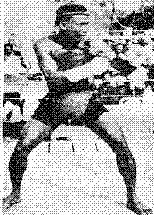 During the reign of King Rama VI, Thai boxing matches became more widespread. Matches that
used to be held in make-shift rings in any available courtyard, became a standard raised ring surrounded by ropes. The first
ring was built in 1921 at Suan Kularp field.
Although standard rings were available, boxers still bound their hands with rope. Foreign boxers
came to take on Thai boxers. An important free-style match took place between Young Harntalay and Chin Chang from China which
attracted a huge crowd o spectators. The result was that Young Harntalay floored Chin Chang with a beautiful kick. In this
period, they also had referees in the ring, and kept time by the clock. These innovations were probably adopted from abroad.
Rope binding was need until 1929 when boxing gloves took its place. Earlier at the Lumpini
Park Ring, a Filipino boxer gave an international style boxing exhibition with boxing gloves. Later, gloves were also used
in student boxing matches called "Muay Farang", and in professional international boxing between Thai and foreign boxers.
This led the organizers of Thai-Style boxing to see that gloves are less dangerous than rope-binding, and decided that gloves
should be adopted in Muay Thai, but fighting with elbows, knees, feet and fists would still be allowed.
Although many improvements or changes were applied, from the type of ring, breaking each bout
into rounds, using the minute-system of time-keeping, and using gloves, one aspect of Thai-style boxing remained the same
-- the jock -- strap. Originally, the jock-strap consisted of a triangular-shaped pillow tied to the waist, with a strap tied
behind from between the legs.
The pillows were red or blue colour according to the boxer's corner. These pillows were used
until one boxer went to Malaysia and saw foreign boxers use jock-strap. He brought the idea back to Thailand, and since then,
jock-strap have been replaced the triangular pillows.
During the reign of King Rama VI, Thai boxing matches became more widespread. Matches that
used to be held in make-shift rings in any available courtyard, became a standard raised ring surrounded by ropes. The first
ring was built in 1921 at Suan Kularp field.
Although standard rings were available, boxers still bound their hands with rope. Foreign boxers
came to take on Thai boxers. An important free-style match took place between Young Harntalay and Chin Chang from China which
attracted a huge crowd o spectators. The result was that Young Harntalay floored Chin Chang with a beautiful kick. In this
period, they also had referees in the ring, and kept time by the clock. These innovations were probably adopted from abroad.
Rope binding was need until 1929 when boxing gloves took its place. Earlier at the Lumpini
Park Ring, a Filipino boxer gave an international style boxing exhibition with boxing gloves. Later, gloves were also used
in student boxing matches called "Muay Farang", and in professional international boxing between Thai and foreign boxers.
This led the organizers of Thai-Style boxing to see that gloves are less dangerous than rope-binding, and decided that gloves
should be adopted in Muay Thai, but fighting with elbows, knees, feet and fists would still be allowed.
Although many improvements or changes were applied, from the type of ring, breaking each bout
into rounds, using the minute-system of time-keeping, and using gloves, one aspect of Thai-style boxing remained the same
-- the jock -- strap. Originally, the jock-strap consisted of a triangular-shaped pillow tied to the waist, with a strap tied
behind from between the legs.
The pillows were red or blue colour according to the boxer's corner. These pillows were used
until one boxer went to Malaysia and saw foreign boxers use jock-strap. He brought the idea back to Thailand, and since then,
jock-strap have been replaced the triangular pillows.
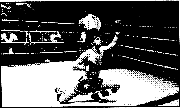 During the reign of King Rama VII, in the revolutionary period, permanent boxing stadiums were
established both in Bangkok and the provinces. They gradually disappeared in 1942 during World War II. After the war, boxing
stadiums sprang up like mushrooms overnight. Skilled boxers from up-country flocked to Bangkok to take part in tournaments.
Finally the first standard boxing stadium was established - The Rajdamnern Stadium, in 1945.
Rules were set, and later on regular bouts were set at 5 rounds of 3 minutes each, with two-minutes
interval between rounds. The weight was taken down in stone like race-horse, and later converted into kilograms. In the early
days, the match-maker system was used; the stadium officials would organize matches providing cup or talent jackets as prizes.
Matches were not classified into weight groups until many years later when the pound system replaced stones and kilograms.
International names were given for each weight group, such as flyweight, and bantamweight.
Matches were arranged to select a champion for each class, following the international style.
Muay Thai is still developing, but what remains unchanged is the use of the pipe and the drums
as musical accompaniments for the matches, and is considered a unique characteristic of Muay Thai. Muay Thai has been initiated
under many names, which have not received prolonged interest because the original has already became known world-wide.
During the reign of King Rama VII, in the revolutionary period, permanent boxing stadiums were
established both in Bangkok and the provinces. They gradually disappeared in 1942 during World War II. After the war, boxing
stadiums sprang up like mushrooms overnight. Skilled boxers from up-country flocked to Bangkok to take part in tournaments.
Finally the first standard boxing stadium was established - The Rajdamnern Stadium, in 1945.
Rules were set, and later on regular bouts were set at 5 rounds of 3 minutes each, with two-minutes
interval between rounds. The weight was taken down in stone like race-horse, and later converted into kilograms. In the early
days, the match-maker system was used; the stadium officials would organize matches providing cup or talent jackets as prizes.
Matches were not classified into weight groups until many years later when the pound system replaced stones and kilograms.
International names were given for each weight group, such as flyweight, and bantamweight.
Matches were arranged to select a champion for each class, following the international style.
Muay Thai is still developing, but what remains unchanged is the use of the pipe and the drums
as musical accompaniments for the matches, and is considered a unique characteristic of Muay Thai. Muay Thai has been initiated
under many names, which have not received prolonged interest because the original has already became known world-wide.
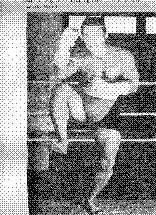 Many additions have been made to the regulations of Muay Thai. It is forbidden now to hit the
private parts since this technique has become quite infamous as a form of attack and is considered debasing for the fine art
of Thai boxing.
Muay Thai remains a national art form. If all parties concerned help to uplift and conserve
this form of martial arts, and pass it onto following generations, it will remain a valuable possession of the Thai nation.
Many additions have been made to the regulations of Muay Thai. It is forbidden now to hit the
private parts since this technique has become quite infamous as a form of attack and is considered debasing for the fine art
of Thai boxing.
Muay Thai remains a national art form. If all parties concerned help to uplift and conserve
this form of martial arts, and pass it onto following generations, it will remain a valuable possession of the Thai nation.

|

